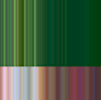
When people see my color streams, the first question I always get is "What do you plan to do with them?"
Truth be told, I'm still trying to figure that out. I'm pursuing a few possible tracks though, and I haven't yet found the end of any of them:
- Mapping the sound spectrum "directly" onto the color spectrum, and seeing what it looks like.
- Making pretty pictures. Where the first track fails to be colorful, or interesting (which it so far hasn't), I'd like to tweak the algorithm to "see more" of the interesting aspects of the sound, and create interesting visuals.
- From nearly the start, it was my hope that I could take advantage of the eye's knack for pattern recognition, and use that to maybe recognize real speech and words, using color. Following this to the extreme, even to allow deaf people to see sound. I'm finding reality might stop this idea short of that end, but I'm seeing how far it goes anyway.
The next comment I always get is, "It would be great if it was a live stream, so you could see it while you heard it."
I had always pictured this as an eventuality for this project, or at least an ideal. These static strips of color are just approximations of the ideal which is probably a live leftward-scrolling color stream (the right hand edge being "exactly now"). Aside from this being beyond my current programming skills, for now I'm just developing the idea, and finding out what's possible.
* Image above: color stream of "color stream FAQ", spoken.










